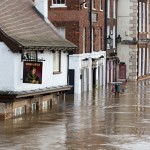The high risk of flooding in the north of England is crippling the value of homes, new research has revealed. According to third party mortgage administrator HML, properties classified as at high risk from flooding in the North West and Yorkshire and Humber regions of England increased in value half as fast between 2005 and […]
 The high risk of flooding in the north of England is crippling the value of homes, new research has revealed.
The high risk of flooding in the north of England is crippling the value of homes, new research has revealed.
According to third party mortgage administrator HML, properties classified as at high risk from flooding in the North West and Yorkshire and Humber regions of England increased in value half as fast between 2005 and 2014 as those at no flagged risk (17% compared to 9%).
HML got its results by comparing the risk of flooding assigned to each postcode by the Environment Agency and average house price sales in each area.
Andrew Jones, chief executive at HML, said: “A flood can devastate a community, but there is a huge hidden cost to those at high risk in much of the north of England.
“The high risk of flooding for some areas accentuates the regional disparity of property price changes, meaning other, safer areas, particularly Greater London, are seeing far greater increases than areas at risk.
“As well as the threat of damage and of course injury from floods, households at risk also therefore face a greater chance of falling into negative equity and reduced chances of sale.”
The most striking difference was in Yorkshire and Humber where the value of properties in high risk postcodes is growing at 6% compared to 16% for no flagged risk.
In the North West, the value of properties in high risk postcodes increased at 6% compared to 15% for no flagged risk.
The storms which battered the UK over Christmas have turned out to be some of the worst in living memory. The devastating flooding that Storms Desmond, Eva and Frank inflicted has left thousands homeless as well as causing untold damage to property and businesses.
Initial estimates of economic losses put the figure between £1.6 billion to £2.3 billion, with the insurance industry bearing between £700 million to £1.2 billion of this.
If the rain persists and places continue to struggle with flooding, total economic losses could breach £3 billion, according to accountancy firm PwC.
Meanwhile, consultancy group HIS believes the flooding could wipe up to 0.2% off the UK’s economic output this year.
Domenico Del Re, head of catastrophe management at PwC, said: “Recent additional flooding once again highlights a need to recognise that the introduction of Flood Re and the rebuilding of flood defences will not automatically solve the affordability of flood insurance, nor will it stop flooding when severe rain falls. Following the 2007 floods, a lot of work was undertaken on flood defences but clearly more can be done.”
Government response
The government is coming under increasing pressure over its response to the crisis. Prime Minister David Cameron has been criticised for not doing enough to protect the country and cutting funding for flood defences.
Environment Minister Liz Truss told MPs this week that around 6,000 houses in England were flooded as a result of the extreme rainfall last month.
Defending the government’s response to the crisis, she said that flood defences have protected over 20,000 properties.
Making a statement in the Commons, Truss said that following the wettest December in a century rivers in Lancashire were at record levels, while Yorkshire rivers like the Aire and the Wharfe were up to a metre higher than they have ever been.
“This resulted in the flooding of about 9,000 properties which, together with the earlier flooding in Cumbria, brings the total to around 16,000 flooded properties in England,” Truss said.
“Whilst of little consolation to those who have been flooded, it’s important to note that flood defences have protected over 20,000 properties.”
Shadow Environment Secretary Kerry McCarthy questioned whether the government’s capital budget of £2.3 billion over six years for flood defences was enough, given the risk of climate change.
“Rather than a sticking plaster response every time the floods hit, with vague promises and random numbers that are forgotten by spring, we need a long-term co-ordinated approach,” she said.
Cameron has pledged £40 million to repair and rebuild flood defences affected by the storms. He said £10 million would be used to improve the Foss barrier which protects York, while the remaining £30 million would be spent on defences on other rivers in northern England.














